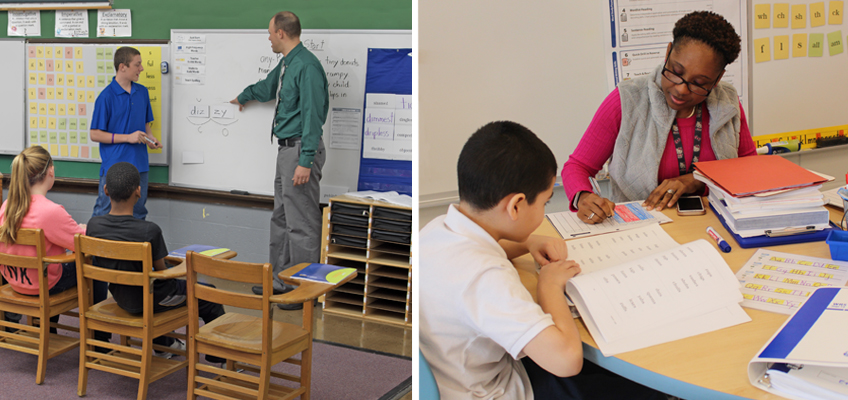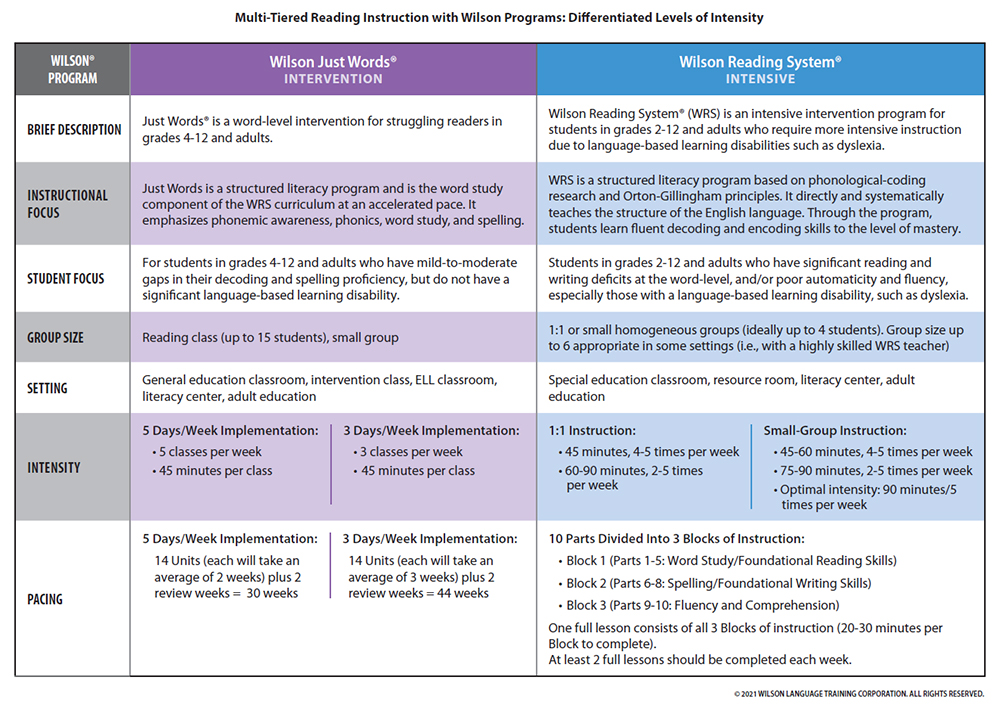
You might be wondering if your struggling reader is a candidate for Just Words® or the Wilson Reading System® (WRS). If so, you’re not alone—many teachers face the same question. That’s why Wilson provides straightforward guidance to help with student identification, a critical first step in intervention.
Instructor-led workshops and courses, teacher manuals, and online support resources provide guidelines for placing students in the appropriate Wilson program. The guidelines, however, aren’t absolute, so it’s important that student placement is informed by a Student Support/Response to Intervention (RtI) team and/or Individualized Education Program (IEP) team.
“Reading deficits fall on a continuum from mild to moderate to severe, but nevertheless impact a student’s performance and potential,” shared Wilson® Credentialed Trainer (W.C.T.) Jeanne Morgan, Teaching Assistant Principal at Waterford Public Schools in Connecticut, and President of the Dyslexia Society of Connecticut.
“Appropriate identification and analysis of a student’s strengths and challenges helps develop an individualized literacy plan that is most effective and efficient while maintaining core academic instruction.”
Let’s take a look at the key differences between Just Words and WRS and the important steps and measures that come into play when selecting the appropriate intervention.
Is Just Words the Right Fit?
Developed as a Tier 2 intervention, Just Words is a highly explicit program for students in grades 4-12 and adults who have mild to moderate gaps in their decoding and spelling proficiency, but who do not have a significant language learning disability such as dyslexia. The program’s name reflects that it’s just the word study component of the WRS curriculum at an accelerated pace. As such, it moves quickly through word structure instruction and can be completed in one year.
The targeted, high-quality literacy instruction provided in a Just Words class helps students build the word-level skills they need to achieve academic success in English Language Arts (ELA) and other subject areas. In the current educational climate, Just Words may prove especially helpful for educators looking to close learning gaps caused by COVID-19 related instructional disruptions.
For a successful Just Words class, proper student placement and grouping is key. This means groups should consist of no more than 15 students who are similar in age, grade, and cognitive ability. Additionally, grouped students should share similar scores on word identification and spelling measures. On a related note, it’s important for teachers to use more than total reading scores and comprehension scores to determine class placement.
Another grouping tip to keep in mind concerns the pretesting or screening of students. Whenever possible, this should happen in the spring semester prior to the start of instruction. The benefits of this are twofold: it allows time to properly set up Just Words classes and reduces the risk of inappropriate grouping due to scheduling issues.
Who should be pretested/screened? All at-risk students who have district reading scores or standardized reading scores below the 50th percentile should be tested or screened in advance. If appropriate, class performance and other underlying factors should also be considered when determining which students to screen.
The Test of Silent Word Reading Fluency-2 (TOSWRF-2) and spelling subtests from the Word Identification and Spelling Test (WIST) are examples of screening measures that can be administered to provide an assessment of word reading fluency and spelling. Students who score between the 16th and 50th percentiles in either subtest should be considered for a more detailed diagnostic assessment. This will help determine if placement in a Just Words class is appropriate, and if so, guide the grouping of students according to their percentile scores and areas of deficit. The WIST Word Identification and Sound-Symbol Knowledge subtests can be used for this purpose also, as they will provide a student’s Fundamental Literacy Ability Index.
Students with a Fundamental Literacy Ability Index score between the 16th and 50th percentiles are likely to be selected as Just Words candidates. However, some students who fall into this range, particularly students who score between the 16th and 30th percentiles, may need a more intensive reading intervention. These individuals, along with students who score at or below the 15th percentile, should be further assessed for placement in WRS.
Is Wilson Reading System the Right Fit?
WRS, the foundation of all other Wilson programs, is an intensive Tier 3 curriculum for students in grades 2-12 and adults with a language-based learning disability, such as dyslexia. Highly explicit, systematic, and cumulative, it’s suited for students who aren’t making sufficient progress with their current intervention or have been unable to learn with other teaching strategies.
Additionally, WRS candidates often exhibit:
To determine if WRS instruction is the appropriate course of action, it’s important to begin with an evaluation of a student’s foundational reading and spelling skills. This may be done using norm-referenced reading assessments that measure word identification, word attack, and spelling. If a student scores low in these areas, it’s likely they haven’t mastered the basic skills necessary for reading and writing. While the student would likely benefit from WRS instruction, a comprehensive educational evaluation is often needed, particularly for a student with dyslexia. The evaluation will clarify academic strengths and weaknesses, fully determine if WRS instruction is appropriate, and guide instructional pacing and progress.
It’s not uncommon for students who lack reading fluency skills to score below expected levels on reading comprehension subtests. To address this, WRS is infused with extensive instruction of comprehension strategies using both narrative and informational text. Furthermore, some students demonstrate weak reading comprehension even when they have word-level skills. Attentional problems and/or weaknesses in working memory, vocabulary, or oral language/listening comprehension abilities are possible causes.
In other situations, students may demonstrate phonological awareness and alphabetic knowledge, but show weak rapid naming/processing speed and/or orthographic memory. Therefore, these students will struggle with reading fluency and comprehension. In such cases, WRS is an appropriate intervention because it builds skills in orthographic processing and automaticity of word reading while simultaneously working on fluency and comprehension.
Alternatively, students who lack phonological awareness, working memory, and rapid naming are often the most severely impaired in reading and require a more intensive implementation of WRS with an experienced instructor. In such cases, WRS is the intervention of choice because it’s more comprehensive than Just Words, providing additional practice and application of skills and targeted diagnostic teaching. All of these are required for students with language-based learning disabilities, such as dyslexia.
After a student is identified as appropriate for WRS, but before the start of instruction, pretesting with the Wilson® Assessment of Decoding and Encoding (WADE) should take place. The WADE is used to obtain a baseline that will determine a student’s placement and potential pacing through the early Steps of the program.
These guidelines, combined with knowledgeable input from students’ IEP or RtI teams, will assist with proper program placement, and as a result, will improve student outcomes.
“The goal is to reach and teach as many students as possible who have reading deficits of all severities with evidence-based instruction and to ensure they reach their literacy and learning potential,” stated Jeanne. “Appropriate placement in Just Words and WRS enables us to meet students where they are in their literacy skills, and then provide the appropriately prescriptive program to effectively and efficiently move them through the intervention process.”
For more information about appropriate program placement, visit our website pages: Just Words Student Identification and WRS Student Identification.
